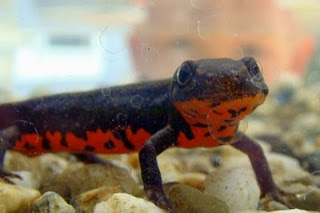Home
Overhunting Feared After Online Newt Sales Top 5,000 A Year
Online sales of newts, including a near-threatened species, have skyrocketed in Japan, raising concerns about overhunting and potential ecological damage, according to an environmental activist and researcher.
More than 20,000 online transactions involving newts were carried out over the 11 years through last year. The amphibians are easily found in ponds and rivers across the country, and more people are keeping them in tanks at home.
Shigeharu Terui, who is involved in the preservation and research of salamanders and other animals, is urging the public not to causally buy newts through online auction sites.
"Awareness of the issue needs to increase among consumers, and measures should be taken against websites trading in living creatures," Terui said. "Legislation may have to be introduced to stop the move as well."
Terui monitored wild newt transactions on Japan's largest auction site, Yafuoku (Yahoo! Auction), from 2009 to 2019. The results, published in the amphibian and reptile journal Caudata in October, showed 14,594 Japanese fire belly newts and 5,939 sword tail newts were sold during the period.
While around 100 fire belly newts were annually sold on the site until 2015, the figure soared to more than 5,000 in 2018 and 2019.
The trade volume for sword tail newts also increased sharply.
Terui, who said there is deep-rooted criticism against agents who sell amphibians and other animals online, strongly urges people to carefully take care of the newts to the end if they do buy them.
The 2018-2019 period saw a surge in internet searches using the word "imorium," a combination of "imori" (newt) and "aquarium," referring to the practice of keeping the species at home, according to Terui.
The sword tail newt is categorized as a near-threatened species on the Environment Ministry's Red List.
Although the fire belly newt is not in danger of going extinct nationwide, it is included in the most endangered group on Chiba Prefecture's red list.
According to Terui's survey, 2,423 fire belly newts on the auction site were from Chiba Prefecture, the largest number among Tokyo and 31 prefectures where the amphibians were taken.
The huge number of transactions on the internet is believed to have fueled the excessive capture of newts. Species caught in one area and taken to a different location could escape or be released, resulting in negative effects on the local ecosystem.
Oriental Fire-Bellied Toad
Common Name: Oriental Fire-Bellied Toad Scientific Name: Bombina orientalis Average Life Span In The Wild: Up to 20 years Size relative to a teacup: IUCN Red List Status:? Least concernLeast Concern Extinct
Current Population Trend: DecreasingFrom above, the oriental fire-bellied toad seems fairly nondescript—a green toad with black spots blending nicely with the verdant colors of its habitat. It's not until it perceives a threat that this flashy amphibian reveals its true colors.
ToxicityOriental fire-bellied toads secrete toxins from their skin, and they want potential predators to know it. When threatened, they rise up on their front legs and arch their back, sometimes even flipping themselves over completely, to reveal the bright red-and-black coloration of their underside. This behavior, known as the unken reflex, warns predators, "Eat me, and you might croak."
Range and HabitatOne of the most common amphibians in its primary range, oriental fire-bellied toads thrive in northeastern China, Korea, southern Japan, and southern parts of Russia. They are highly aquatic and usually found in slow-moving streams and ponds. When out of water, they stick to the region's coniferous and broadleaved forests. They hibernate from late September to May, sheltering in rotting logs, leaf piles, and occasionally at the bottom of streams.
PopulationOriental fire-bellied toads are medium-sized, growing to a length of about 2 inches. Their backs, covered in spiky-looking warts, can be bright green to brownish gray, and their bellies are smooth.
Tadpoles survive on algae, fungi, and plants, while the adults eat a variety of invertebrates, including worms, insects, and mollusks.
Oriental fire-bellies are popular in the pet trade, but they are common throughout their range and have no special conservation status.
Amazon Is Having Another Sale For Fire Tablets
If you are on the fence, whether or not you want an affordable Fire tablet in your life and have been waiting for them to go back on sale, there is good news. Amazon is currently running a sale, and anyone can participate, no Prime membership is warranted. The company has discounted most of their their entire range, from the Fire 8 to the brand new Fire Max 11. Some of the savings are over $75, so this is a perfect time to get one
Michael Kozlowski has written about audiobooks and e-readers for the past twelve years. Newspapers and websites such as the CBC, CNET, Engadget, Huffington Post and the New York Times have picked up his articles. He Lives in Vancouver, British Columbia, Canada.



Comments
Post a Comment